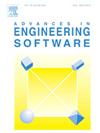Study of influencing factors of performance in novel vertical roller mills
IF 4
2区 工程技术
Q2 COMPUTER SCIENCE, INTERDISCIPLINARY APPLICATIONS
引用次数: 0
Abstract
To optimize the particle motion characteristics in a Vertical Roller Mill (VRM), this study proposes incorporating spiral blades to the outer walls of the ash bucket and the outside of the separator. This design utilizes the space between the ash bucket, separator, middle shell, and upper shell to create specific channels for discharging particles outside the mill. The study employs computational fluid dynamics and powder classification methods to perform a comprehensive numerical analysis of the new VRM. By evaluating the flow field distribution, particle motion characteristics, and utilizing the Q criterion, the research identifies three critical parameters that improve the mill's performance: the width, angle, and number of spiral blades. Numerical analysis results reveal that as the width of the spiral blades increases, both the airflow trajectory and flow field distribution improve, thereby facilitating particle transport. When the angle of the spiral blades decreases, the airflow trajectory aligns more closely with the rotation direction of the blades, which is more conducive to discharging particles from the VRM. Furthermore, as the number of spiral blades increases, the airflow velocity within the spiral channel rises, leading to enhanced particle motion characteristics affected by the fluid. When the spiral blades are fully enclosed, with two turns and eight blades, the vortex distribution becomes more regular and the flow field stabilizes, which reduces unnecessary material recirculation. This study provides valuable guidance for optimizing the structure of the VRM and offers references for improving its internal flow fields, enhancing separation performance, and reducing energy consumption.

求助全文
约1分钟内获得全文
求助全文
来源期刊

Advances in Engineering Software
工程技术-计算机:跨学科应用
CiteScore
7.70
自引率
4.20%
发文量
169
审稿时长
37 days
期刊介绍:
The objective of this journal is to communicate recent and projected advances in computer-based engineering techniques. The fields covered include mechanical, aerospace, civil and environmental engineering, with an emphasis on research and development leading to practical problem-solving.
The scope of the journal includes:
• Innovative computational strategies and numerical algorithms for large-scale engineering problems
• Analysis and simulation techniques and systems
• Model and mesh generation
• Control of the accuracy, stability and efficiency of computational process
• Exploitation of new computing environments (eg distributed hetergeneous and collaborative computing)
• Advanced visualization techniques, virtual environments and prototyping
• Applications of AI, knowledge-based systems, computational intelligence, including fuzzy logic, neural networks and evolutionary computations
• Application of object-oriented technology to engineering problems
• Intelligent human computer interfaces
• Design automation, multidisciplinary design and optimization
• CAD, CAE and integrated process and product development systems
• Quality and reliability.
 求助内容:
求助内容: 应助结果提醒方式:
应助结果提醒方式:


